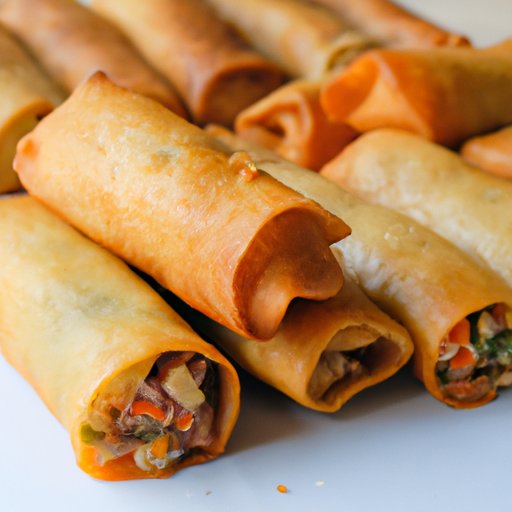
Introduction
Rolling egg rolls can be a tricky step in making this popular appetizer, but with the right technique, anyone can master it. Perfectly rolled egg rolls not only look better but also cook more evenly, creating a delicious, crispy texture. In this article, we’ll cover the basics of rolling egg rolls, advanced techniques, customizations, and variations beyond the traditional egg roll. We’ll also explore the history and cultural significance of egg rolls, along with a comparison of different cooking methods. Let’s roll!
Step-by-Step Tutorial
Rolling an egg roll involves a few simple steps. First, lay your wrapper on a clean surface with one corner pointed at you, creating a diamond shape. Next, add your filling to the center of the wrapper, leaving some space on each side. Fold the corner closest to you over the filling and tuck it tightly. Then, fold in the two sides and roll up the egg roll tightly. Seal the top corner with a bit of water, and you’re done!
It’s important not to overfill your egg rolls, or the filling may burst through the wrapper during cooking. Aim for about two tablespoons of filling per egg roll. When rolling, make sure to tighten the wrapper around the filling, so it doesn’t shift or sag during cooking. For a visual guide to rolling egg rolls, check out our step-by-step tutorial here:
Expert Tips
If you’re looking to take your egg roll rolling to the next level, try out some of these expert tips. First, consider double wrapping your egg rolls for extra durability and crispiness. To do this, layer two wrappers on top of each other before filling and rolling. Another advanced technique is to create decorative cuts in the wrapper before rolling, creating a lacy effect when cooked.
For customization, consider experimenting with different wrappers and fillings. Spring roll wrappers can be used interchangeably with traditional egg roll wrappers, and fillings can range from classic cabbage and pork to unique options like mac and cheese or sushi ingredients. Don’t be afraid to get creative!
Variations on Traditional Egg Rolls
While traditional egg rolls are delicious, there are many inventive variations to try out. For a healthier option, consider using rice paper wrappers and filling with fresh vegetables and herbs. Dessert egg rolls can be made by filling the wrapper with a sweet mixture like cream cheese and fruit, then serving with a dipping sauce like chocolate or honey.
For a unique twist, try out fusion egg rolls, like Korean BBQ or taco egg rolls. These deviations from traditional egg rolls add an exciting new flavor and texture.
Historical and Cultural Background
Egg rolls first appeared in China, where they were traditionally filled with vegetables and meats and fried until crispy. Over time, they spread to different parts of the world, including the United States, where they became a staple of Chinese-American cuisine. In the Philippines, egg rolls are called lumpia, and the filling typically contains minced pork or shrimp. Today, egg rolls are enjoyed worldwide, with variations in filling and cooking methods.
Comparing and Contrasting Different Methods
Finally, let’s take a look at the pros and cons of different cooking methods for egg rolls. Baking egg rolls in the oven is a healthier option than frying, but they may not get as crispy. Frying is the classic method for cooking egg rolls, creating a crunchy exterior and flavorful interior. Air frying combines the best of both worlds, creating a crispy outer layer while requiring less oil than traditional frying.
Ultimately, the choice of cooking method comes down to personal preference and may vary based on the type of egg roll being made.
Conclusion
Rolling egg rolls is a crucial step in creating this beloved appetizer, and with the right technique and creativity, anyone can make delicious, perfectly rolled egg rolls. Whether following a traditional recipe or experimenting with a new flavor combination, egg rolls remain a versatile and culturally significant dish with variations enjoyed around the world.





